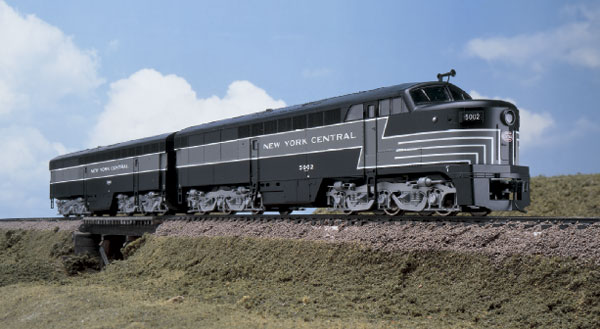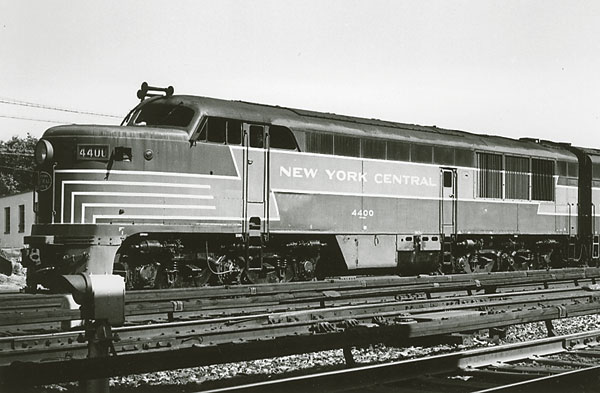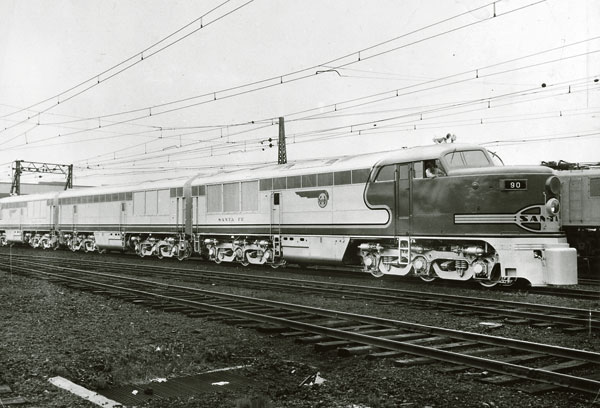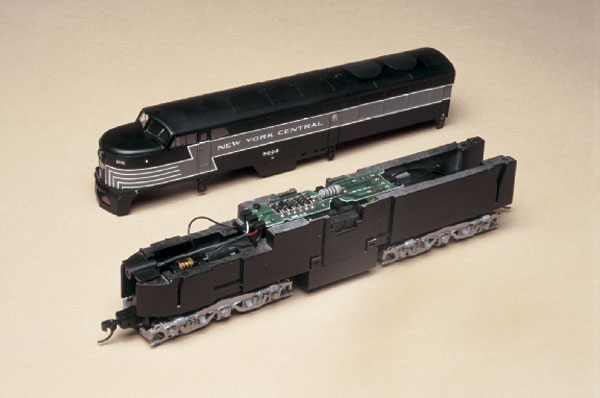When Fairbanks-Morse was ready to put its war-proven opposed-piston diesel engines to work on the railroads, it didn’t yet have the capacity to build large road locomotives on its own. Since FM was dependent on General Electric for locomotive electrical equipment, the arrangement to have the new FM road diesels assembled in GE’s Erie, Pa., locomotive erecting shop seemed natural. That’s how they came to be known as “Erie-builts.”
The Erie-builts were 2,000-hp units with 63-foot streamlined carbodies designed by Raymond Loewy, of GG-1 electric fame. They rode on three-axle trucks with two traction motors each and center idler axles, for an A1A+A1A wheel arrangement. That was an unusual choice for freight service, and in fact the Erie-builts ultimately fared better in passenger duties. Only 82 cab units and 29 boosters were built between December 1945 and February 1949.
The Proto 1000 Erie-built body represents the later cab style and is typical of the majority of the units built. The air horn mounting is a little unusual, as only the Pennsylvania RR’s Erie-builts sported a single horn thrust out above the windshield center post.
Except for the trucks the models accurately represent the dimensions, proportions, and details of their prototypes. The trucks have 42″ wheels, and Eries could be ordered with either that size or 40″ diameter. There’s a dummy diaphragm at the rear of the A and both ends of the B unit, but the couplers are mounted to keep the diaphragms from touching. Coupled locomotives would look better with tighter spacing and working diaphragms, but you’ll have to use your ingenuity for that.
The wheels match the NMRA standards gauge, and the integral-spring knuckle couplers match Kadee’s no. 205 coupler height gauge.
The mechanism is essentially the same as in the Proto 2000 Alcos, with a central, flywheel-equipped can motor driving all six axles through universal shafts. The Eries pick up current from all wheels and are very heavy for HO models. The drawbar pull for a single unit is equivalent to 80 free-rolling HO freight cars on straight, level track, and with the powered booster the A-B combination doubles that pull.
The Eries run smoothly and quietly throughout their speed range, which is a bit slower than their prototypes’ – Erie-builts with a 68:19 gear ratio and 40″ drivers were rated for 75 mph. The starting voltage may seem a little high, but the models are equipped with diode-bridge constant lighting to let the headlight come on before the locomotive starts to move. Though it has no headlight, the B unit has the same wiring so its speed matches the A’s.
Our samples are painted and numbered for New York Central freight-service Erie-builts in the series 5002-5005 (A units) and 5100-5101 (Bs). These locomotives were delivered in 1948 and 1949 and retired in 1960 and 1963. The original freight paint scheme had the gray stripe stopping before the radiator shutters at the rear of the A, and the B painted solid black, but the models have a later version with full striping on both units. The Central also had two 1947 freight As, 5000 and 5001, and six passenger As (4400-4405) built in 1949 with cast trucks and steam generators.
Other Erie-built users included (later cabs except as noted):
- Atchison, Topeka & Santa Fe, one A-B-A passenger set (no. 90 LAB).
- Chicago & North Western, four A units for passenger service.
- Kansas City Southern, six As and three Bs for freight service, first two As with early cabs, first four (including two Bs) with fabricated trucks.
- Milwaukee Road, 14 As and six Bs for passenger service, most with early cabs and stainless steel nose trim for Olympian Hiawatha trains.
- Pennsylvania RR, 36 As and 12 Bs for freight service.
- Union Pacific, eight As and five Bs for passenger service, the first two As with early cabs and the first five units (four As, one B) with fabricated trucks.
Life-Like has done a real service for early diesel modelers and anyone else who admires these handsome though relatively rare locomotives. I’ll be glad to put Santa Fe 90 and some of her UP sisters to work on my Cajon Pass layout.
Price: A-B sets, $130, A units $65
Manufacturer:
Life-Like Products, Inc.
1600 Union Ave.
Baltimore, MD 21211-1998
410-889-1023
www.lifelikeproducts.com
Description:
Ready-to-run plastic and metal diesel locomotives
Features:
Constant-brightness headlight
Drawbar pull: 5.75 ounces (10.4 ounces for A-B set)
Engine weight: 23.5 ounces (one unit)
Minimum radius: 15″
Road names:
Atchison, Topeka & Santa Fe
Chicago & North Western
Kansas City Southern
Milwaukee Road
New York Central (freight)
Pennsylvania RR
Union Pacific

















